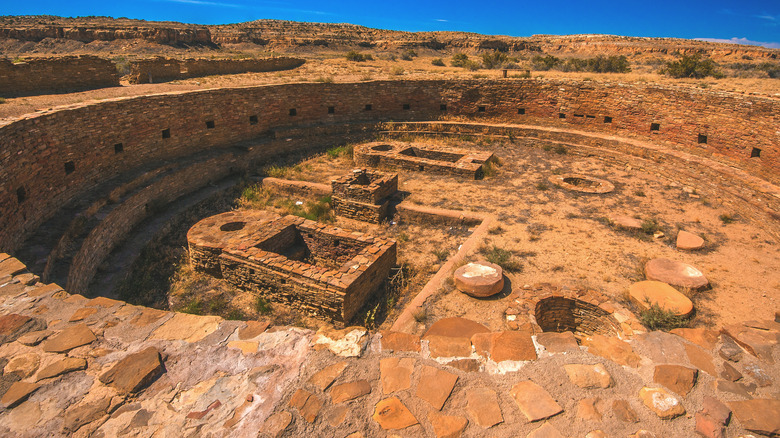The Real Reason The Anasazi Civilization Disappeared
When you think about civilizations that rose and fell, you may picture the ancient Egyptians, Greeks, or Romans. But it's important to remember that the Americas were full of similarly influential ancient civilizations. Here, your mind will probably drift to the Mayan, Aztec, or Incan empires of modern-day Latin America. But the lands now known as the "United States" had their fair share of complex civilizations as well. One particularly notable group was the Ancestral Pueblo culture, commonly called the Anasazi.
According to the Encyclopedia Britannica, the Anasazi civilization emerged sometime around 100 A.D. It was based in the Four Corners region of the modern United States, with lands in today's Arizona, New Mexico, Colorado, and Utah. The Anasazi civilization lasted for centuries. Sometime around 500-750 A.D., the Anasazi transitioned from hunting and gathering to an agriculture-based society, and adopted a sedentary lifestyle. Following this, the Anasazi built more advanced stone buildings, including some sprawling structures with up to 1,000 rooms, per Britannica. Some Anasazi dwellings were built directly into cliff walls and canyons. By the 1200s A.D., the Anasazi had developed a complex social structure, large cities, irrigation systems, and more. They're also well known for their beautiful basket work and pottery.
After over 1,000 years of development, it all came crashing down. Shortly before 1300 A.D., the Anasazi stopped building and left their homeland entirely, abandoning the stone structures and complex cities they had constructed. The question historians and archaeologists ask is: Why?
The Anasazi likely fled their homeland due to widespread drought and conflict
Archaeologists have put forward a number of theories about why the Anasazi fled from their homeland so suddenly. According to Smithsonian Magazine, one theory is that a band of nomadic raiders pushed the Anasazi off their land. Archaeological evidence to support this theory, however, is scant.
Other researchers have attributed the sudden migration to cultural factors. For example, in the century leading up to the migration, it's believed that the Anasazi culture became increasingly violent. Conflict and executions were common, and cannibalism was not unheard of. It could be that this cultural shift led the Anasazi to seek a fresh start somewhere else. The descendants of the Anasazi have their own oral traditions surrounding the flight of their ancestors, but Smithsonian suggests that these stories are "closely guarded secrets."
Per NPR, the dominant factor that led the Anasazi to flee was likely a widespread drought that struck the region at the end of the 1200s. A drought could certainly explain why the Anasazi fled so suddenly, searching for lands with better access to water. Drought could also explain the increase in violence among the desperate Anasazi in the decades leading up to their migration.
Still, even this explanation is a bit unsatisfying; Smithsonian writes that the Anasazi had already dealt with a longer, more intense drought in the 1100s without abandoning their homeland. Drought was certainly a contributing factor, but the complete, true explanation remains a bit of a mystery.

